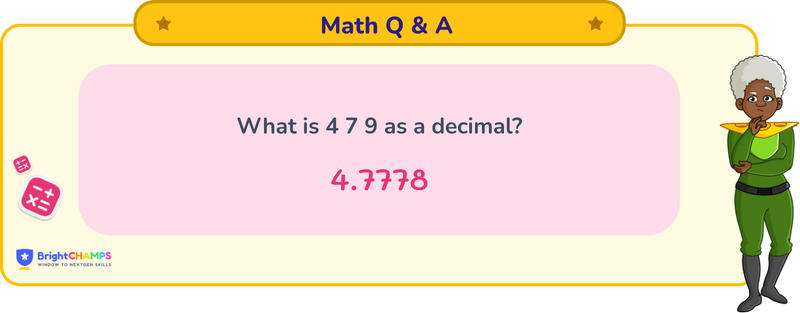
 210 Learners
210 LearnersLast updated on August 5, 2025

4 7/9 as a decimal

It is a simple question on decimal conversion. Firstly, we have to learn fractions and decimals. A mixed number represents a whole number and a fraction together. The whole number is written before the fraction, here it is 4. The fraction part has a numerator (number on the top), here 7, which represents how many parts out of the whole, and a denominator (number below), here 9, which shows how many parts make the whole. A decimal is a way to represent a number that is not whole, using a decimal point (.) to separate the whole part from the fraction part. The numbers to the left of the decimal point represent the whole, and those to the right represent the fractional part.
What is 4 7/9 as a decimal?

Answer
4 7/9 in decimals can be written as 4.7777..... It is a recurring decimal, showing it will repeat the same digit infinitely.
Explanation
To get 4 7/9 in decimal, we will convert the fraction 7/9 to a decimal and then add it to the whole number 4.
Let's see the step-by-step breakdown of the process:
Step 1: Identify the whole number and the fraction. Here, the whole number is 4, and the fraction is 7/9.
Step 2: Convert 7/9 to a decimal by using the division method. As 7 is smaller than 9, we will use decimals to divide 7 by 9, which will give us 0.7777...
Step 3: Add the decimal result of the fraction 0.7777... to the whole number 4.
The resulting sum is 4.7777..., a recurring decimal.
Important Glossaries for 4 7/9 as a decimal
- Mixed Number: A number consisting of an integer and a proper fraction.
- Fraction: A numerical quantity that is not a whole number, representing a part of a whole.
- Decimal: A number that uses the base ten and includes a decimal point to separate the whole part from the fractional part.
- Recurring Decimal: A decimal in which one or more digits repeat infinitely.
- Division Method: A process used to convert a fraction into a decimal by dividing the numerator by the denominator.




